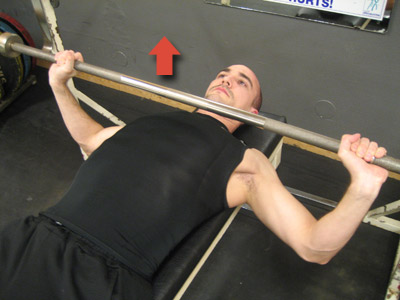What is an ectomorph / hard gainer and why do they have a hard time building muscle?
Before we get into the actual details on the skinny guy workout plan and how to build muscle fast, let’s first define the trainee we’re dealing with and his unique characteristics.
An ectomorph is described in the Merriam Webster dictionary as being “characterized by a lean slender body with slight muscular development.” Ectomorphs are considered the “hard gainers” of the fitness world since they have a hard time building muscle and very high metabolism. They’re your typical “skinny guy” and are usually physically characterized by having:
- A skinny frame
- Flat chest and flat abs
- Long skinny limbs (arms and legs)
- Virtually zero body fat (a blessing and a curse!)
- “Bony” body structure

(Photo: istolethetv)
The disadvantage of being a hard gainer
It goes without saying that skinny guys are left in a big disadvantage in many aspects of life; one aspect being physical competitions and sports. It doesn’t matter how skilled you are in sports, if you can’t hold your ground against your bigger competitors you will eventually get overpowered. Another big disadvantage is having lower confidence levels and self-esteem. This has an effect not only in physical sports but also in ALL aspects of life, ranging from personal well being to social interactions.
It’s clear then, taking into account their physical attributes, that skinny guys are faced with a challenging task when it comes to muscle building. So how should they go about building muscle? Let’s discuss…
Is it possible for hard gainers / skinny guys to build muscle?
The first question that needs to be addressed is simple: is it even realistically possible for hard gainers / skinny guys to build muscle?
Good news fellow skinny guys: it’s very possible to build muscle. (Take it from me; I’m a hard gainer!)
The goal must be unique to one thing: muscle building. This is achieved through a highly targeted form of training termed “hypertrophy” training: the process by which muscles are grown in size.
In addition to training for hypertrophy, hard gainers must also optimize their training program so that muscle development is maximized. They have to intelligently balance their workouts, diet, and recovery to maintain muscle growth. Mess with one and you mess with total results.
How fast can a skinny guy build muscle?
And here’s the thing, not only can skinny guys build muscle, they can build muscle fast and easily. In fact, it should also be fun. The process of building muscle has many positive side effects. One of which is the release of endorphins that make us feel good after a workout and during the entire training program.
If the training is not fast and easy, it’s not done right. I can’t emphasize this enough. Many trainees think that they need to bust their butt in the gym, pumping countless sets and repetitions for as long as possible and in as many workouts as possible just to be able to put on muscle.
No need! You’re just wasting your time and energy. The key is to train smart, not necessarily hard.
How long does it take (realistically) for skinny guys to build muscle?
I’ve mentioned a few times now that skinny guys can build muscle fast, but how fast are we talking? How fast should a hard gainer expect to build muscle (realistically)?
The answer is dependent on a few factors, including: age, fitness level, and genetic potential. Typically speaking, a 12-week period is a realistic window for trainees to build muscle. That’s because 12 weeks gives you just enough time to incorporate the necessary cycles required to cause stress and adaptation in the body to see results. The higher the fitness (experience) level of a trainee, the faster he will be able to gain muscle – sometimes even less than 12 weeks. However, 12 weeks should be the maximum time required for ANY type of trainee to see SOME results.
If in 12 weeks there are no visible results, then either the training program is not effective, or the trainee is not following the program properly.
What are the best kinds of exercises for building muscle?
When it comes to exercise types for muscle building purposes, there are only two types to consider: compound (core lifts) and assistance exercises. That’s it.
Compound exercises are often times labeled as the “multi-joint” exercises, because they require multiple joint movements in a single repetition, or the “core lift” exercises, because they’re supposed to make up the core of any training program. I will use all of these terms interchangeably, but just know that they all mean the same thing. The compound exercises are 5 in total:
- The Squat;
- The Deadlift;
- The Bench Press;
- The Military Press;
- The Pull-up; and
- All of their corresponding variations. (Different grips and angles.)
Assistance exercises, on the other hand, refer to your typical accessory exercises that usually limit movement to a single joint and target very specific muscles. They can also be referred to as “isolation” exercises because they isolate certain muscles.
Compound vs Assistance exercises
So how should a hard gainer pick and choose his exercises? Should he focus mainly on the compound exercises, or is it better to do more assistance exercises since you can specifically target each muscle that you want to build?
Mark Rippetoe, in his book Practical Programming for Strength Training, states, “When training for mass, specialization is less effective than globalization. The endocrine system responds in a dose-dependent manner to stress. Large-scale, multi-joint, functional (sometimes called “structural”) exercises are most effective in producing an anabolic hormonal stimulus than small scale, single-joint, isolation-type exercises, even when using the same intensities and repetition scheme.”
Their ability to initiate significant hormonal responses in the body, coupled with their effectiveness in targeting a large group of muscles at once, means compound exercises are best type of exercises when it comes to muscle building. They should be the “bread and butter” of any effective training program. Assistance exercises, on the other hand, are meant to do exactly what they’re named for: to assist the compound exercises.
This is very important to understand: the main goal of assistance/isolation exercises is NOT to build muscle in certain areas. Rather, it is to help make your core lifts stronger.
Because it is in the core lifts where all of the muscle building will happen!

(Photo: Ulf Liljankoski)
The question remains though, how should we incorporate the core lifts? Let’s discuss some more.
How should you lift weight to maximize muscle building? (Rep range, number of sets, and rest intervals)
What differentiates hypertrophy (muscle building) training from strength training is not the exercises but rather how they’re used. Repetition range, number of sets and rest intervals are all factors that can be adjusted to optimize pure muscle building. Further optimization for muscle building can be made by adjusting cycle lengths and total training/program duration.
Mark Rippetoe mentions in his book Practical Programming For Strength Training that “muscular hypertrophy is produced by using higher reps, 8 to 12 RM (65 to 85%) or more of the same exercise.”

Furthermore, the TOTAL number of reps (volume) across all working sets (not including warm-up sets) should be about 18 to 30 reps for the novice-level trainee.
This means you might be doing 5×5 (25 reps), 3×8 (24 reps), or even 3×10 (30 reps).
There are many different variations to play around with. The exact structure (sets x reps) will depend greatly on several factors, including the type of exercise being performed, the desired goal/results, and the trainee’s level of adaptation.
Every type of trainee will have to find what works best for him.
Rest intervals between sets
Rest intervals is another factor that should be adjusted to optimize muscle building results. In his book Practical Programming for Strength Training, Rippetoe argues that shorter rest intervals are best for hypertrophy. This is because lactic acid production and hormonal release seem to lead to increases in muscle mass.
The idea is that rest intervals should be limited as much as possible without sacrificing form. In other words, rest only as much as you need to catch your breath between sets. Again just like sets and reps, this will ultimately depend on the nature of the exercise. (Note: compound exercises will require more rest than assistance exercises).
How many workouts per week should you do?
Many uninformed trainees fall into the trap of the “more is better” attitude, so they hit the gym as much as 5 or 6 times a week to “work each muscle” in the body so they can build muscle fast. The problem with this method is it doesn’t work. In fact, working out that many times per week at full intensity is worse than working out just ONCE per week.
So what’s the ideal number of workout days per week? Well, it depends.
2 to 4 workouts per week are ideal, depending on how you want to structure your workouts. My personal experience, as a true hard gainer, has shown that 2 to 4 workouts per week is optimal for balancing stress and adaptation for the muscles.

The exact number of workouts per week will also depend on several factors, including which phase/cycle of the program you’re currently doing, the intensity of each workout, and your ability to recover from workout to workout.
It is not recommended to splits routines into separate muscle groups (i.e. arm day, chest day, back day, etc.), because this can easily lead to overtraining: a state in which zero progress is made and the rate of muscle building actually regresses.
Diet tips for hard gainers to build muscle fast
So far, we’ve only addressed the training part of muscle building. But we can’t possibly discuss muscle building without also addressing diet and nutrition.
Truth is: without proper diet and nutrition, you can throw all that we’ve discussed out the window! When it comes to muscle building, training, diet and recovery all play an EQUALLY important role. Ignore one of the three, and you’ve ignored all three. So it’s no secret that diet is crucial – it ensures that our training hasn’t gone to waste.
But here’s the problem: hard gainers have a hard time eating. We simply don’t have the appetite for it. So how should we go about getting enough nutrition?
Simple: count your proteins, and let the rest take care of itself. In contrast to a weight-cutting trainee who has to count his calories, hard gainers must count their protein instead. But that’s it! Don’t worry about how many daily calories you’re getting, don’t worry about the number of carbohydrates and fats – those will all take care of themselves when you keep it simple. Important note: this method does NOT work for “skinny fat” bodies, which requires more defined optimization of nutrition intake. “Skinny fat” is a term used for body types with increasing belly fat while having a relatively “skinny” frame.
Aim for 1 gram of protein per 1 pound of bodyweight, per day. So if you weigh 140 pounds, you will need about 140 grams of protein spread out throughout the day. It’s important to remember that this is simply a GUIDELINE for how much you need. You don’t need EXACTLY 140 grams every day. But as long as you stay close to that number, you will still build muscle.
Keep it simple
Keep things simple by taking your daily protein target (total grams) and divide it by the total number of meals/snacks per day to determine how much protein you need per meal/snack.
|
Total Body Weight (lbs) |
Total Grams of Protein per Day | Grams of Protein per Meal (3 meals) | Grams of Protein per Snack (3 snacks) |
| 140 | 140 | 30 | 17 |
(3 meals) x (30g) + (3 snacks) x (17g) = 141g of protein
In their book Easy Strength, Dan John and Pavel Tsatsouline suggest to “eat three meals a day. Snack three or four times a day. I’d prefer each meal be a meat, egg, fish or poultry-based meal… Snack? Well, you can get away with dietary murder on a bulking program.” Meaning, don’t fret the details when snacking – just be sure to include a small portion of protein and you’ll be well on your way to building muscle fast.
Don’t obsess so much about meeting your daily protein target. Instead, focus on getting high quality protein in every meal and snack you consume. And keep meals/snacks to 5 or 6 per day. Let the carbs and fats take care of themselves.
Important note: this method does NOT work for “skinny fat” bodies, which requires more defined optimization of nutrition intake. “Skinny fat” is a term used for body types with increasing belly fat while having a relatively “skinny” frame.
Rest and recovery tips to build and maintain muscle mass
Much like diet, quality rest and recovery is equally important to optimize muscle-building results and to maintain those results for a very long time. As a hard gainer trying to build muscle fast, your main goal is to maximize the stress/adaptation effect: stress is caused in the gym, adaptation happens during the time between workouts. Adaptation is where the muscle building actually happens, so it’s easy to see why recovery is a huge factor to our goal. Ignore recovery, and you mess with your results (or even hurt them through overtraining).
- Maximize sleep, aiming for minimum 7-8 hours or as much as it takes to wake up fresh.
- Fit in a 20-30 minute nap during the day, if possible.
- Keep workouts to no more than 2 to 4 per week, as discussed previously.
- Keep total workout time to maximum 60 minutes per workout – if you go beyond 60 minutes, you’re overtraining and sacrificing recovery time.
- Incorporate strategic breaks – 1-week minimum – by structuring the training program into short cycles or phases to allow the body to recover.
RECAP ON HOW TO BUILD MUSCLE FAST
- Ectomorphs (skinny guys) are the hard gainers of the fitness world because they have a hard time putting on significant muscle mass due to very high metabolism rates.
- It is very possible for hard gainers to gain muscle by focusing their workout program on hypertrophy.
- Muscle building for skinny guys should be fast and easy, otherwise the risk of overtraining becomes too high.
- A 12-week training period is typically sufficient time to experience some muscle mass gains.
- Compound exercises (aka multi-joint exercises, core lifts) are the best form of exercises to build muscle fast and easily.
- The optimal range of repetitions for maximum muscle development is 18 to 30 reps across all working sets. The exact sets x reps numbers will depend on the exercise, the goal, and the trainee’s level of adaptation.
- Minimize rest intervals (between sets) as much as possible to maximize muscle growth.
- 2 to 4 workout-days per week are ideal to balance breakdown and growth in the muscles. More than 4 workouts and you risk overtraining. Less than 2 workouts and you may not cause enough stress to maximize muscle building.
- Aim for consuming 1 gram of protein for every pound of bodyweight, per day. But focus on counting protein per meal/snack only – don’t worry about other factors at this point.
- Maximize recovery rate by getting enough sleep (minimum 7 to 8 hours), limiting workout time to no more than 60 minutes, and cycling your workouts into strategic phases.
Find a good workout program
Remember that a well-designed training program doesn’t attempt to solve a problem through concrete numbers. Any good resource, whether it is an article such as this one, a book, or a training program, should solve muscle building by giving ranges of numbers, criteria that must be met, and guidelines to follow that can be fine-tuned to each unique individual.
As world record bench presser J.M. Blakley said, “Keep your programs simple. Avoid distractions. Complex programs are wrought with pitfalls and drain the focus. Do only things that help most. Concentrate your energies on doing few tasks well, rather than many tasks poorly.”
Happy muscle building!
Yous Kas
P.S. If you’re confused about any of the tactics described above, leave a comment below and I’ll answer your questions directly.
————
RELATED & RECOMMENDED POSTS
The Best Mass Gainer for Skinny Guys is NOT Weight Gainer Protein
Cardio and Muscle Loss: Is Cardio Bad for Muscle Building?
Author: Yous Kas


Recent Comments